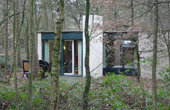Everyone has at some time enjoyed a holiday in a holiday park, and yet extremely little is known about their development and architecture. Fear of overdeveloping the open countryside is what gave rise to this typically Dutch phenomenon, discovered PhD candidate Mieke Dings.
The Netherlands, with over fifteen hundred holiday parks spread across the country, has one of the highest concentrations of such parks in the world. It typifies the government's compulsion to organise everything in the Netherlands, observes Dings in her PhD thesis 'Tussen tent en villa. Het vakantiepark in Nederland 1920-nu' (Between tent and villa. The holiday park in the Netherlands 1920-present). ‘The government wanted to encourage people from towns and cities to discover nature. However, it was scared to death of isolated summer houses in the landscape. And this is why they structurally encouraged the building of holiday resorts.’
As early as 1927 the provincial government in Friesland introduced a ‘summer-house by-law’. In the 1930s, the Veluwe Regional Plan actually focused completely on combating separately developed summer houses. Indeed, what would remain of the country's natural beauty if buildings simply started appearing everywhere? The tent was hardly a suitable alternative either, because a piece of cloth would never be enough to keep the sexes apart in the countryside. Dings: ‘Holiday parks, with houses as a structural element, could accommodate the masses of holiday goers and were therefore seen as the saviour of nature.’
Many of the oldest holiday parks had their origins in the socialist workers youth movement. But there were also farmers who had empty poultry sheds or workers' cooperatives who would set something up together. More commercial parks, such as the standardised formulas of Sporthuis Centrum and later Vendorado, started to spring up from the 1960s. This standardised formula meant holiday goers knew exactly what they could expect.
But the days that every holiday park had to look the same are now in the past. Modern chains such as Center Parcs and Landal Green Parks build worlds of experience, or unique parks around a ski run, an indoor water park or special themes.
For many years, the government encouraged the construction of large-scale parks and designated locations through subsidisation. That forced park developers to employ the services of an architect. But did the architects take up the challenge? Not always, observes Dings. ‘From the 1960s, many architects actually looked down on such work. Holiday parks were often seen as a lower form of amusement, for the masses.’ Even so, a few major names in architecture were still keen to throw themselves at the design task. Gerrit Rietveld realised the first design for a bungalow park in an ‘airy’ style on Schiermonnikoog (1959). Jaap Bakema designed bungalows for Sporthuis Centrum with sliding doors to maximise the connection with nature and in a semi-detached formation to maximise land space. Dings: ‘Bakema saw the holiday park as a laboratory for the living environment. He tried things out that could also possibly work in a normal urban environment.’ Matthijs Zeelenberg became famous for his holiday parks in Zeeland, such as Port Zélande and De Banjaard (Roompot). It also gained him international success as far away as China.
Today, spatial planning is no longer the only reason for government intervention in the holiday-home sector. A good holiday park brings in revenue. And this is something that municipalities and provincial governments have been all too aware of since the 1980s. Traditional Dutch holiday parks, seen as ‘an enjoyable holiday together’, attracted tourists from far beyond the national borders. Dings: ‘For many people, the holiday-park concept radiates something of an ideal living environment.’
Published: April 2015
More information
- PhD thesis 'Tussen tent en villa. Het vakantiepark in Nederland 1920-nu' (Dutch only)
